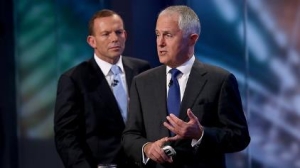Tony Abbott wakes up this morning in a different role, unexpectedly preparing for life after Prime Minister. It seems we now might live in a country where we vote a leader in, then the party decides if they want a different person to lead the nation. Turnbull’s first task will not be an easy one; to bring credibility and confidence back to the group who are running the nation. This will need to be done for the voters, for business and for overseas leaders.
So, what can your company learn from politics and in particular, leadership continuity (or lack thereof).
1. Back your leader, and leaders – Back Yourself!
We are living in what I call the “Microwave Age”; if something cannot be cooked in 5 minutes, it’s not worth it! This short-term, interchangeable attitude of society today makes it extremely difficult for a leader to take a medium or long term view of the organisation over which they preside. However, getting the strong support of his or her executive and management team allows the leader to have conviction, trust and patience in the decisions made to bring the company forward.
2. Understand your employer and consumer brand will be hurt through fractious leadership and short tenures
It doesn’t matter if you are a local café or an international blue-chip; the market will judge you if you cannot make a leader stick around, regardless of the circumstances. Change is inevitable, but it doesn’t need to be frequent at the leadership level.
If your company had 4 leaders in 4 years, your brand would probably be in the disarray that Australian federal politics finds itself part of now. And, much like I imagine Federal Ministers and staff be thinking this morning, your team will live in perpetual confusion as to their role going forward given the short term nature of the leader(s) they operate under.
3. Take the time to succession plan
Succession planning is not just about deciding which internal employees are ready for the step-up, although this is an important part of it. Succession planning is giving consideration, consultation and debate to what the next leader will look like, years from now. A lot of our work with forward-thinking organisations involves engaging in the dialogue of the next leader, long before the company starts to recruit for that person.
4. Drive a strong culture of collegiate and unified management and leadership
Together, We Achieve More. An obvious statement. But, looking at the inner workings of our federal political parties, one can see how the opposite achieves very little. The distraction of divisive behaviour and a lack of togetherness has massive consequences for all levels of the organisation. At executive level, disagreements and debate are necessary, but rifts are not.
As a leader, encourage diversity, debate, differences but harness a strong culture of unification amongst your next level of leaders. The team will see this congruency and feel safe inside it.
5. If you need to make change, make it once and get it right
Leaders are succeeded, and change is healthy. We are not desperately hoping that the change made in Parliament last night will be a lasting one; God knows we cannot handle another PM change any time soon. If you need to make change, put the necessary work in to the thoughts and consultation around the change to make it a sustainable change.
Brian Briscoe, Managing Director


Follow Briscoe Search